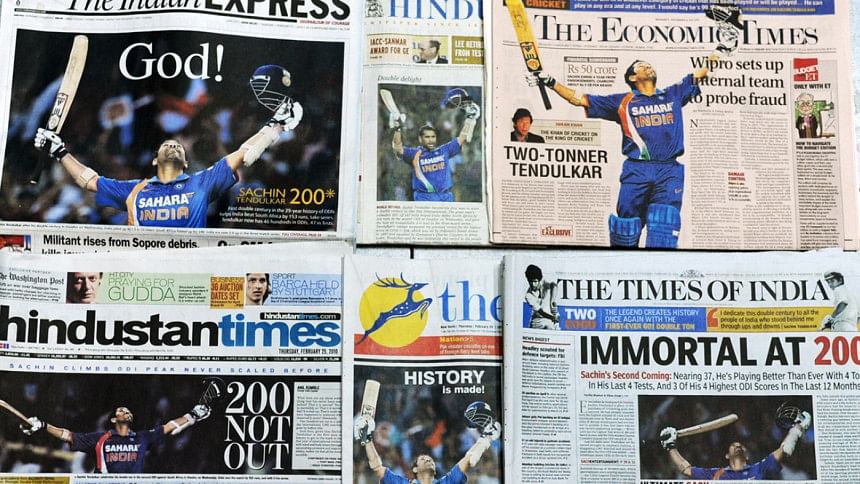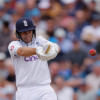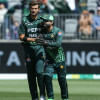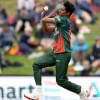The 36-year-old double-centurion

2010
Sachin Tendulkar became the first batsman in one-day history to break the 200-run barrier. And it took him just 147 balls. He got to 191 in the 45th over and was able to cruise to the landmark despite facing only nine deliveries of the last 30. The unfortunate opposition was South Africa and the lucky spectators those of Gwalior. India scored their second 400-plus total in three months and won the match by 153 runs. Saeed Anwar's record of 194, equalled by Charles Coventry in 2009, had remained intact for nearly 13 years. Tendulkar's was overtaken in under two years, by Virender Sehwag (219), following which Rohit Sharma made two double-centuries, 209 in 2013 and a whopping 264 in 2014.
2015
And exactly five years later, Chris Gayle came to the double-ton party with the fastest such innings overall, and the first in World Cups. It was surprising that Gayle hadn't got there before, given his T20 exploits (remember the 175 off 66 balls in the 2013 IPL?). It happened against Zimbabwe in Canberra. After surviving a close lbw appeal on his first ball, Gayle took 105 balls to get to his century, 21 more to get to 150, and another 12 to 200 - all this while facing 59 dot balls. His partnership of 372 with Marlon Samuels broke the previous record for any wicket - set by Sachin Tendulkar and Rahul Dravid against New Zealand in 1999 - by 41 runs. Zimbabwe lost the rain-curtailed game by 73 runs.
1951
A Test average of 33 suggests the ordinary, but Derek Randall, who was born today, was anything but that. Nicknamed "Arkle" after the great steeplechase horse for lapping his Nottinghamshire team-mates during training, he was restlessness personified in the field, but in a brilliant way: nobody was safe backing up prematurely while Randall lurked. His high point as a batsman was a glorious 174 in the Centenary Test at the MCG in 1976-77, but he was often a nervous starter - he made 14 ducks in 47 matches - especially against the moving ball. He averaged 44 batting at No. 6 or 7, and only 29 batting anywhere higher. He made two hundreds in New Zealand in 1983-84, but it didn't cut him much slack. The first Test of the following summer, when Randall made 0 and 1 against West Indies at Edgbaston, was his last. A legend at Trent Bridge, he carried on for Notts until 1993.
1931
The birth of Dennis Brian Close. Few players have a Test career that spans more years than matches, but Close did: he played 22 matches between 1949 - when he was England's youngest cricketer, at 18 - and 1976, although he was never fully forgiven by the England selectors for a feckless stroke at a crucial stage against Australia at Old Trafford in 1961. An unselfish character and an outstanding captain of country and county, Close was the definitive gruff Yorkshireman, although he later played for Somerset. He was almost ludicrously courageous, taking blow after blow at short leg. And his autobiography is called I Don't Bruise Easily. Not many people give Wes Hall the charge time after time, but Close did in the classic Lord's Test of 1963, and almost led England to a famous victory.
2003
In their World Cup run to date, Sri Lanka had been devouring the minnows like a barracuda in a rock pool. But unlike Bangladesh (first-over hat-trick) and Canada (36 all out), their third intended victims, Kenya, turned out to be deceptively ravenous piranhas. A target of 211 shouldn't have set the nerves jangling, but in front of an exuberant Nairobi crowd, and on a slow and stodgy pitch, the lanky legspinner Collins Obuya took 5 for 24 in 10 immaculate overs to strip the flesh from Sri Lanka's chase. With gleeful celebrations of every wicket, Kenya danced to victory by 53 runs, and their march to the semi-finals was underway.
1949
England's Indian jewel is born. Left-arm seamer John Lever played over a third of his 21 Tests in India, and took all three of his five-fors there. He was a regular visitor to India after he swung his way to 10 for 70 on his Test debut in Delhi in 1976-77, when he also made his only Test fifty. His Test career looked over when he went on the rebel tour of South Africa in 1981-82, but Lever was surprisingly recalled at 37 against India at Headingley in 1986. He took six wickets and did not do a lot wrong, but England were stuffed and the selectors turned to fresh blood in the shape of Neal Radford for the next match.
1990
With 14 defeats in 15 against their opponents, and fresh from a 0-4 Ashes pasting, England's Caribbean tourists seemed ripe for a blackwashing. When Gordon Greenidge and Des Haynes added 62 without breaking sweat in the first Test in Kingston today, everything was going according to the script. Then Greenidge went for a second run on a Devon Malcolm misfield and was beaten by a tracer bullet from long leg. David Capel, of all people, then prised the door ajar with two quick wickets, and Angus Fraser booted it down with 5 for 6 in six overs. At the end of a delirious first day England were 80 for 2, only 84 behind West Indies, and well on their way to an astonishing victory.
1959
Mike Whitney, who was born today, had played only six first-class matches when he was called up, while playing for Fleetwood in the Lancashire League, to make his Test debut in the crucial Old Trafford Test in 1981. That ended in tears when Ian Botham belted an Ashes-winning century, but Whitney, a lively left-arm seamer, forged a decent, if brief, career for himself 10 years later. In 12 Tests he took two seven-fors, including 7 for 27 against India in Perth in 1991-92. He later became a TV presenter.
1996
A unique record for Javed Miandad, who became the first man to appear in six World Cups when he took to the field against the United Arab Emirates in Gujranwala. He didn't have much to do, though, taking one catch in Pakistan's easy nine-wicket win.
1958
The double of a century and 10 wickets in a Test match was achieved for the first time. In the women's Test against England in Melbourne, Betty Wilson - known as the "Lady Don" - had a match haul of 11 for 16, including a 7 for 7, and scored 100 in Australia's second innings. The match ended in a draw.
1987
Chamara Kapugedera, born on this day, rose through age-group cricket in Sri Lanka and made his ODI debut at 18, against Australia in Perth in 2006, and immediately impressed with his composure. Considered a possible opener in one-day cricket, he scored a maiden fifty against Pakistan in March 2006 and followed that with his first Test fifty against England, at Trent Bridge. He narrowly missed getting a maiden century against Bangladesh when he was dismissed for 96 in Chittagong. Though he made his Test debut in 2006, he had only played eight Tests by the end of 2009. He fared better in ODIs but failed to make a century in nearly 100 matches.
1981
Mohammad Sami, born today, initially forced his way into the Pakistan Test team with outstanding performances in domestic cricket and had an immediate impact in his first Test, with eight wickets against New Zealand. Then, in only his third Test, he picked up a hat-trick, a feat he managed in an ODI as well. After the 2003 World Cup, Sami, expected to become Pakistan's lead strike bowler, fell away and was overtaken by Rana Naved-ul-Hasan, Umar Gul, Mohammad Asif and Mohammad Amir. After a stint in the ICL he made an unexpected and brief comeback into the Pakistan squad in 2010. Five years later he made another limited-overs return, playing two ODIs and two T20s at home against Zimbabwe.
2009
A run-fest in Karachi. Mahela Jayawardene and Thilan Samaraweera scored double-centuries (Samaraweera would go on to make another double, in the ill-starred Lahore Test before it took an ugly turn) and added a world-record 437 for the fourth wicket to take Sri Lanka to 644 for 7. Pakistan replied with 765 for 6, following a triple-century from Younis Khan and an unbeaten 158 by Kamran Akmal. Sri Lanka had used nine bowlers and Muttiah Muralitharan and Ajantha Mendis bowled a total of 124 overs for 329 runs for a wicket each. Sri Lanka managed 144 for 5 in their second innings before the stumps were drawn.

 For all latest news, follow The Daily Star's Google News channel.
For all latest news, follow The Daily Star's Google News channel. 








Comments